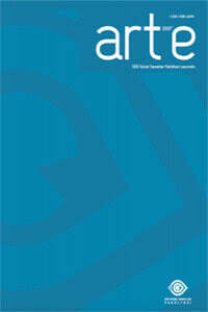Creative Performance Measurement in Design Education: Product Dimension
CREATIVE PERFORMANCE MEASUREMENT IN DESIGN EDUCATION: PRODUCT DIMENSION
Design education, Performance measurement, Product dimension, Fashion design Industrial design,
___
- Besemer, S. P. (1998). “Creative product analysis matrix: testing the model structure and a comparasion among products-three novel chairs”, Creativity Research Journal, Vol 11, No 4, p. 333-346.
- Besemer, S. P. and O’Quin, K. (1999). “Confirming the three-factor creative product analysis matrix model in an american sample”, Creativity Research Journal, Vol 12, No 4, p. 287-296.
- Casakin, H.P. (2007). “Methaphors in design problem solving: implications for creativity”, International Journal of Design, Vol 1, No 2, p. 21-33.
- Christiaans, H.H.C.M. (2002). “Creativity as a design criterion”, Creativity Research Journal, Vol 14, No 1, pp. 41-54.
- Davis, M.L. (1987). Visual Design in Dress (Second Edition), USA-New Jersey: Prentice- Hall Inc.
- Demirkan, H. and Hasirci, D. (2009). Hidden dimensions of creativity elements in design process, Creativity Research Journal, Vol 21, No 2-3, p. 294-301.
- Harpe, de la B., Peterson, J.F., Frankham, N, Zehner, R., Neale D., Musgrave, E. and McDermott, R. (2009). “Assessment focus in studio: what is most prominent in architecture, art and design?”, International Journal of Art and Design Education, Vol 28, No 1, p. 37-51.
- Hasirci D. and Demirkan H. (2003). “Creativity in learning environments: the case of two sixth grade art-rooms”. The Journal of Creative Behavior, Vol 37, No 1, p. 17-41.
- Hasirci D. and Demirkan H. (2007). “Understanding the effects of cognition in creative decisionmaking: a creativity model for enhancing the design studio process”, Creativity Research Journal, Vol 19, No 2, p. 259-271.
- Hennessey, B. A. (1994). “The conselsual assessment technique: an examination of the relationship between ratings of product and process creativity”, Creativity Research Journal, p. 193-208.
- Horng J-S. and Lin, L. (2009). “The development of a scale for evaluating creative culinary products”, Creativity Research Journal, Vol 21, No 1, p. 54-63.
- Karasar, N. (2005). Bilimsel Araştırma Yöntemi. Ankara: Nobel Yayn Dağıtım.
- Kidd, L.K. and Workman, J.E. (1999). “Assessment of creativity in apparel design”, Clothing and Textiles Research Journal, Vol 17, No 1, p. 58-64.
- Linn, L.R. and Miller, M.D. (2005). Measurement and Assessment in Teaching. (9th Edition). New Jersey -USA: Pearson Education Inc.
- Mozota Borja De, B. (2006). Tasarım Yönetimi, çev. Sibel Kaçamak, İstanbul: MediaCat Kitapları.
- Nitko, A.J. (2004). Educational Assessment of Students. (4th ed.). USA-New Jersey: Pearson Education Inc.
- Varol, E. (2010). Moda Tasarımı Egitiminde Tasarımların Degerlendirilmesine Yönelik Bir Ölçme Aracı Geliştirme, Doktora Tezi, Gazi Üniversitesi, Eğitim Bilimleri Enstitüsü, Giyim Endüstrisi ve Moda Tasarımı Eğitimi Anabilim Dalı, Ankara, Türkiye.
- Yıldırım, A. ve Şimşek, H. (2008). Sosyal Bilimlerde Nitel Araştırma Yöntemleri. (6.Baskı). Ankara: Seçkin Yayıncılık.
- Yayın Aralığı: 2
- Başlangıç: 2008
- Yayıncı: Süleyman Demirel Üniversitesi Güzel Sanatlar Fakültesi
Mekan ve Moda İlişkisi: Bir Workshop Deneyimi
Marka Değerine Etkileri Açısından Reklamlardaki İmgeler ve Göstergebilimsel Açıdan Değerlendirme
Tüketim Kültüründe Sanatın Tüketim Nesnesi Olarak Sunumu
Bir Sosyal Farkındalık Projesi Bağlamında Grafik Tasarım Uygulamaları
Bilge KINAM DOKUZLAR, Tevfik Fikret UÇAR
Klasik Gitar Eğitiminde Parmaklandırma (Fingering) Yaklaşımları
KARABÜK İLİ SAFRANBOLU İLÇESİ KAYMAKAMLAR MÜZE EVİ’NDE BULUNAN BİNDALLI ELBİSELER
Gülüzar Çelebilik, Ayşe Çengel
Mobilya Tasarımında "Yeniden Kullanım": Tasarımdan Üretime Dönüşüm
Gülçin Cankız ELİBOL, İsmail BEZCİ, Vildan DÜNDAR TÜRKKAN, Adem VAROL
Karabük İli Safranbolu İlçesi Kaymakamlar Müze Evi'nde Bulunan Bindallı Elbiseler
Gülizar Çelebilik, Ayşe Çengel
Mobilya Tasarımında "Yeniden Kullanım": Tasarımdan Üretime Dönüşüm
Gülçin Cankız ELİBOL, İsmail BEZCİ, Vildan DÜNDAR TÜRKKAN, Adem VAROL
